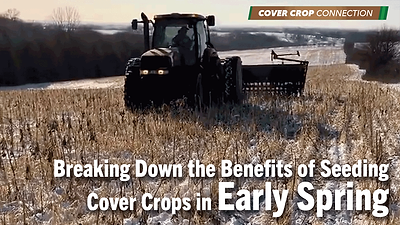Soil compaction is a common and constant problem on most farms that till the soil. Heavy farm machinery can create persistent subsoil compaction. Scientists have found that compacted soils (a) physically restricted root growth; (b) decrease root zone aeration; and (c) reduces drainage, (d) increased losses of nitrogen from denitrification, (e) increases soil erosion. Soil compaction may persist for 10 years or longer before nature (freezing and thawing) solves the problem.
Subsoilers typically operate at depths of 12-18 inches to loosen soil and alleviate compaction. When subsoiling removes a hard pan, traffic must be controlled or compaction will reoccur. If a hard pan does not exist, equipment traffic on damp soils can create one. Research indicates that yield increases from deep tillage are rare, and short-lived. Hard pans are primarily the result of tillage (smearing wet soils) at any depth (shallow or deep), and not so much wheel traffic. Fuel, labor, equipment, and time makes subsoiling an expensive operation. Subsoiling dry soils (although more effective) requires even more fuel.
Low organic matter levels make soils more susceptible to compaction. Surface crop residues cushion the effects of soil-compacting forces. Crop residues can be compressed but retain their shape (like a sponge) once the traffic has passed. Tillage accelerates soil organic matter (SOM) decomposition with a 60% decrease in SOM in the last hundred years. Soil organic matter (roots, root exudates) is usually bound to soil particles (especially clay particles) to form soil aggregates (micro and macro) which resist compaction.
Micro-aggregates (less than 0.01 inch) are very small fine soil clay particles surrounded by SOM. Roots and microbes combine micro-aggregates to form larger macro-aggregates, which allows the soil to crumble, an indication of good soil structure. Macro-aggregates are larger in size (greater than .01 inch), are less stable, and give soil structure; allowing for greater air flow and water infiltration. Compacted soils tend to have more micro-aggregates than macro-aggregates. Tillage causes a loss of SOM and the macro’s to break down into micro-aggregates, leading to poor soil structure and denser soil with increased soil compaction. Soil compaction is a result of macro-aggregate depletion by tillage.
For example, have you ever seen a farmer excessively till a soil until the soil is fine as dust (micro soil aggregates)? When it rains and the soil dries out, the soil turns to concrete. Macro-aggregates hold 80% of the carbon and plant available nutrients. Macro-aggregates allow our soils to breath, water to infiltrate, and stores water while allowing excess water to drain away.
Glomalin is a glycoprotein created by combining a protein from mycorrhizal fungus with a complex sugar contained in plant root exudates. Glomalin acts like a glue to cement micro-aggregates together to form macro-aggregates (crumbly soil), which improves soil structure. Glomalin initially coats the plant roots and then coats soil particles.
In order for glomalin to be produced, plants and mycorrhizal fungi must co-exist. Glomalin needs to be continually produced because it is readily consumed by bacteria and other soil microbes. Bacteria thrive in tilled soils because they are more hardy and smaller than fungi, so bacteria numbers may increase rapidly in tilled soils. Fungi live longer and need more stable conditions to survive. Fungi grow better under no-till soil conditions with a continuous living cover and a constant supply of carbon food sources. Since fungi do not grow as well in tilled soils, less glomalin is produced and fewer macro-aggregates are formed. With fewer macro-aggregates, a soil is more likely to possess poor soil structure and is more susceptible to compaction. Thus, susceptibility of soils to compaction is a direct result of a biological problem. Soil compaction persists due to a lack of co-existing living roots and mycorrhizal fungi.



